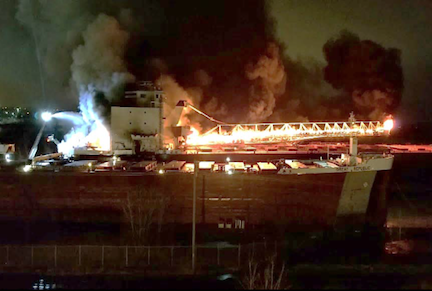The following is text of a news release from the National Transportation Safety Board (NTSB):
(WASHINGTON) — About 2010 local time on Feb. 16, 2019, a fire was reported on the bulk carrier St. Clair while the vessel was laid up for the winter at the CSX TORCO Iron Ore Terminal (TORCO dock) at the mouth of the Maumee River in Toledo, Ohio. No one was on board. The fire was extinguished approximately 36 hours later by shoreside firefighters. No pollution or injuries were reported. The estimated property damage exceeded $150 million.
Probable cause
The National Transportation Safety Board determines that the probable cause of the fire aboard the bulk carrier St. Clair was the ignition of combustible material in the vicinity of an engine room workshop likely due to the use of portable space heaters or smoldering smoking materials, which spread to other areas of the vessel. Contributing to the extent of the fire damage was the lack of operating procedures for continuous active monitoring of the vessel while in layup status.
Analysis excerpt
Although the H Hansen employee had identified smoke within the engine room at 1645, he assumed it was residual smoke from the hot work that occurred in the No. 6 port ballast tank and therefore did not investigate it further. This smoke was most likely emitting from a smoldering hotspot, possibly from a burning piece of wood or trash, which eventually developed into the fire that severely damaged the vessel. By turning on the starboard exhaust fan in an effort to remove the smoke, and leaving it on when he departed at 1800, the movement of air within the engine room may have assisted with accelerating the growth of the smoldering hotspot into a fire.
With no company policy or procedure requiring continuous active monitoring of the vessel while it was in layup status, the fire was able to expand for approximately three hours before the fire department arrived. Since most watertight doors and access manhole covers to ballast tanks remained open, there was nothing in place to stop or hinder the passage of smoke and fire.
Click here to read the complete report.

